
Thanks to a rise in education around sexually transmitted infections (STIs), people are beginning to let go of the taboos that surround the topic, making it easier for openness and honesty around the subject.
Some STIs are far more common than others, and the spread of them can be impacted by many factors, including a lack of awareness, fewer contraception options, and a general sense of shame surrounding the issue.
Because of this, the Manual team has compiled a collection of data to find the most common STIs from across the globe, covering 30 different countries. The findings take into account factors such as whether some STIs are more common in men or in women and why this may be. We also discover which countries are the most anxious about STIs around the world, based on how many Google searches focus on STIs per month, compared to the population of the country.
Paired with exclusive information from Clinical Sexologist Ness Cooper, we aim to offer insight and answers to some of the most-searched-for sexual health questions online.
The most common STIs in England revealed
The most commonly seen STI varies from country to country, but the one that tops the list in the UK is chlamydia. Our research highlighted that, despite there being a 29% fall in diagnoses from 2019 to 2020, there were still a massive 161,672 cases recorded last year. That’s more than one in every 420 people in the UK.

Next up is gonorrhoea, with 57,084 recorded cases in 2020 alone, yet still showing a decrease in diagnoses of 20% from 2019. Third on the list was anogenital warts (1st episode), which our research showed had seen a 46% drop from 2019 to 2020, going from a staggering 50,700 to 27,473 recorded cases.
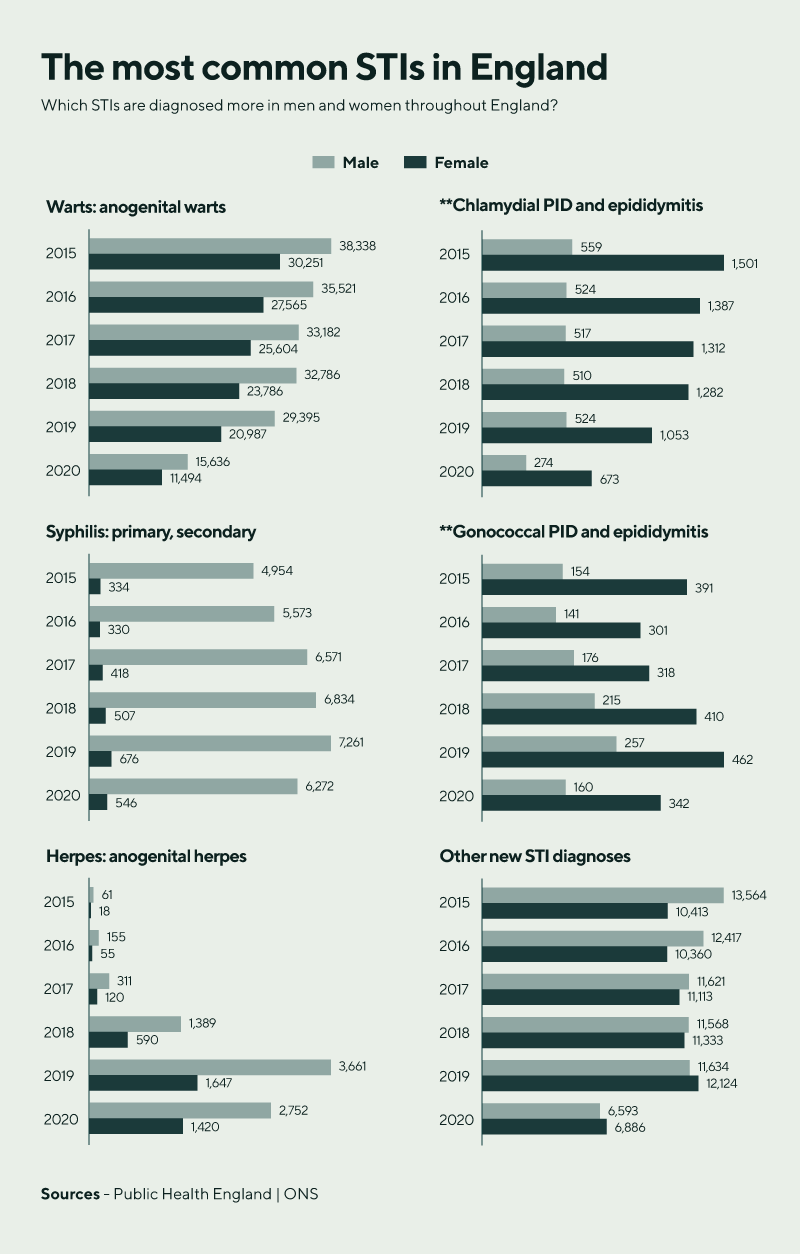
There were 15,705 cases of non-specific genital infections in the UK in 2020, and a whopping 28,546 in 2019, highlighting that while recorded cases have recently dropped, STIs remain a massive problem in England.
Clinical Sexologist Ness Cooper weighed in on how often we should get tested for STIs:
“This depends on the lifestyle of the individual, as testing will be less necessary for people in committed, monogamous relationships. Every three-to-six months is a good time frame to aim for, if you are not having regular sex with the same person. It can also be worth remembering that, after new sexual encounters, some STIs take a while to show up in your system. Chatting with your local sexual health providers can provide more insight into exactly what needs to be done regarding testing.”
The most common STIs for men and women

Are some STIs more commonly seen in men than women? Our research has found that in 2019, there were 101,163 recorded cases of chlamydia in men in the UK. In the same year, there were 125,574 female diagnoses, with a significant drop in 2020 showing 88,674 cases. A similar drop was seen in 2020 recorded male cases, with 70,581 overall.
When it came to gonorrhoea, there were 14,970 male cases in 2011, compared to just 5,965 female cases. In 2019, there was a record 51,312 recorded male cases, with 19,057 in the same year, highlighting that this particular disease is less common in women in the UK.
Both numbers dropped in 2020, with 40,743 for men and 15,509 for women, which could have been a result of a lack of testing during the pandemic. Another factor of pandemic life was fewer opportunities for people to meet in person, potentially leading to fewer opportunities to transmit STIs.
An online study highlighted that sexually active people confessed to not having a new sexual partner in the four weeks following the start of the pandemic, causing numbers to drop from 8% to 4% – which is unsurprising, considering nobody was leaving their house. Despite this, overall, judging from our research, STIs were found to be typically more common for women.
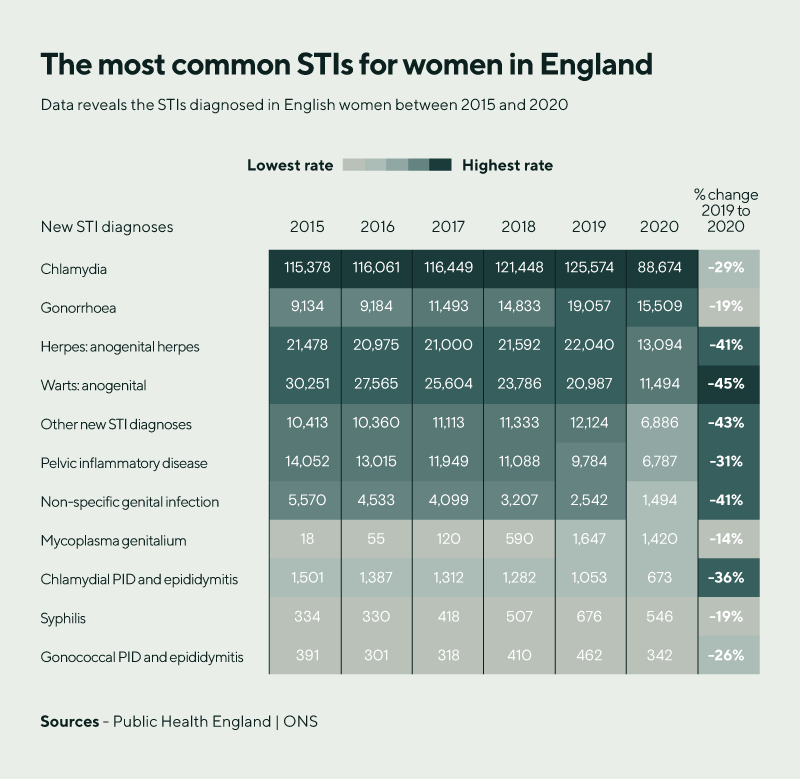
Ness Cooper explained that some individuals may be at higher risk than others:
“Groups of people that experience higher levels of shame are less likely to go and get tested or stick to medication that is required. People that are older are also at higher risk, as a reduced risk of pregnancy can cause them to forget barriers to prevent STIs. People that do not fall into heteronormative categories can also be more susceptible, as anal and oral sex can increase the risk of contracting STIs.”
Does your age play a part in your susceptibility to STIs?
After analysing the different factors that determine how likely we are to contract an STI, one question remains unanswered: does your age play a part? We looked into the ages of male and female diagnoses in the UK, starting from 15 and ending at 65+.
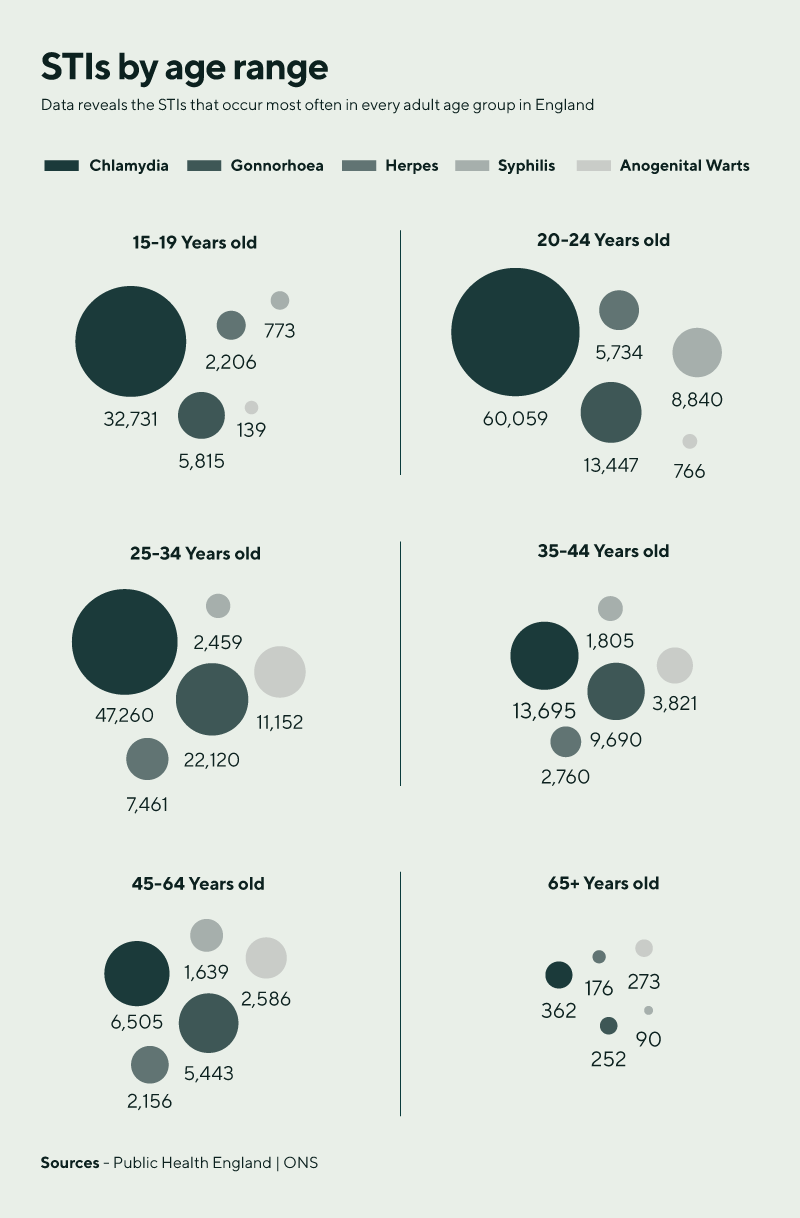
The highest recording of chlamydia cases falls within the 20-24 age range, with 60,059 recorded cases. There were also 8,840 cases of genital warts, and 11,152 in the 25-34 age bracket. This could be due to the fact that 20-24 are usually the ages people choose to go to university, or reach a place of genuine sexual confidence.
The numbers start to drop in the 45-64 age range, with 6,505 cases of chlamydia and 1,639 cases of syphilis. The 65+ age bracket had only 362 recorded cases of chlamydia and 90 cases of syphilis, showing a pattern between younger age groups and a higher risk of STIs, which is most likely down to a lack of education on the matter.
Regional Analysis England: How do different regions compare?
Ness Cooper said: “When it comes to where people live, lots of things can have an impact on how likely you are to contract an STI. For example, was your school progressive or conservative when it came to openness around sex? Were local clinics available for you to regularly test yourself? How insightful was your sex education, and did your school or college offer out free condoms?”
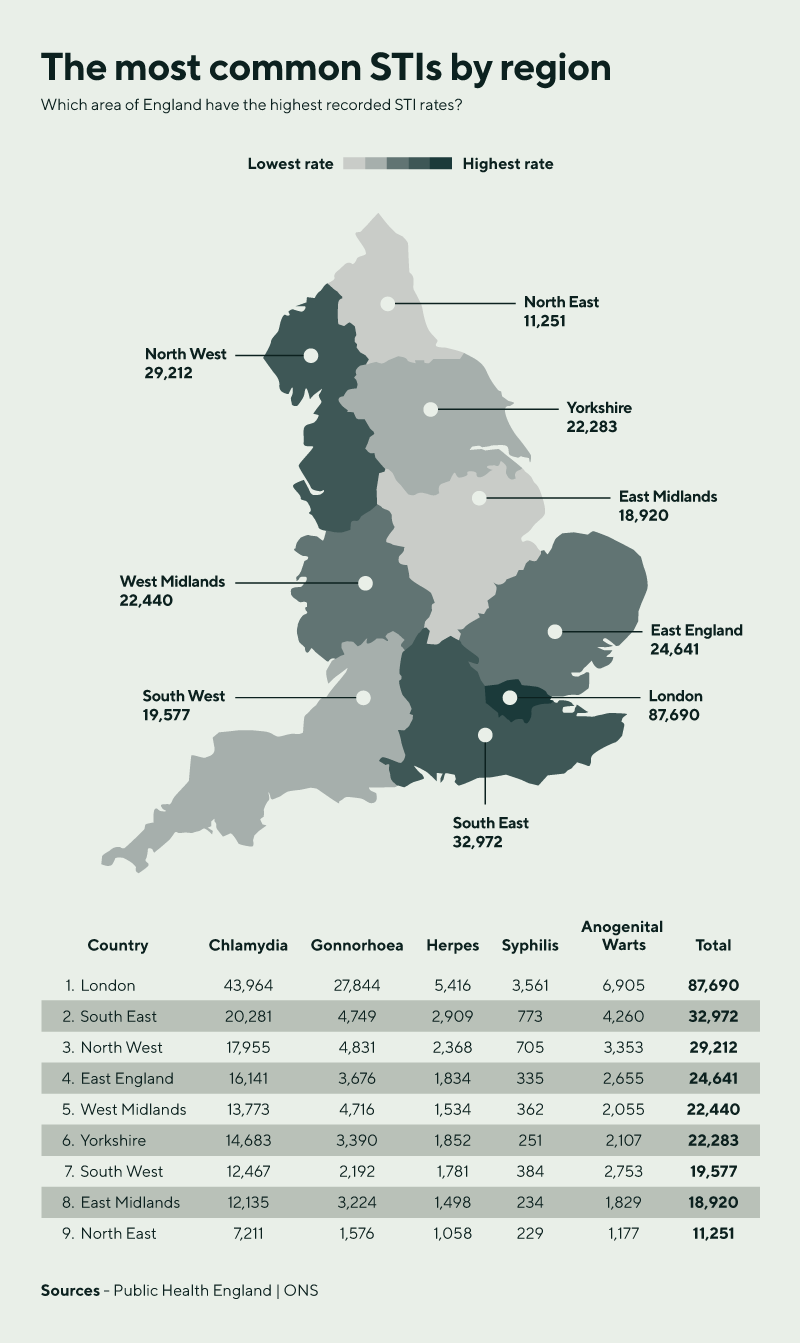
London, with a population of 9,002,488 people, has the highest number of recorded chlamydia cases, 43,964, 0.5% of the population or 1 in every 200 people. This is staggering compared to 13,773 cases of chlamydia in the West Midlands, which could be down to a lack of sexual health clinics and a far smaller population at 5,961,929 people.
The West Midlands also have comparatively low recorded numbers of syphilis cases, with a meagre 362 compared to London’s 3,561. Yorkshire and the Humber, despite having a population of only 5,526,350, have surprisingly high numbers of chlamydia cases, with the third-highest in the list at 14,683.
The second-highest number is East England, with a population of 6,269,161 and 16,141 cases. The overall lowest region is the North East, with a total number of 11,251 cases of chlamydia, syphilis, herpes, genital warts, and gonorrhoea, along with a population of 2,680,763 – the lowest in the list for this category, too.
Sexuality Analysis: How do they compare?
“Using a condom can help to prevent some STIs during anal sex, but not all of them. Sexuality also plays a large part in how many recorded STI cases a country or region has, as some locations have laws preventing the expression of sexuality, while some cultural expectations can play a big factor when it comes to STI prevention and treatment.”
Our research highlighted that, in the last ten years, heterosexual females had the highest number of STI cases, with 68,995 recordings. This includes the greatest number of recorded chlamydia cases, with 31,119 in total.

Ness Cooper shared her insight into why this might be, stating that “the vaginal surface is more vulnerable to sexual fluid than the penis, which is covered in skin and has more coverage. Females are also less likely to experience symptoms, meaning STIs could go unnoticed for longer periods of time.”
Next up were heterosexual men, with a total of 52,140 recorded cases of STIs in the last 10 years. After this, 49,758 recorded cases for people that have penises that sleep with people with the same anatomy.
Ness Cooper highlighted that “there is a potentially lower risk with WSW (women who have sex with women) sex, as manual sex (fingering), sex toys, strap-ons, and oral sex (unless somebody has cuts around their mouth) make transmission less likely as fluids are not directly shared.”
The Cost of STI Treatment – UK and USA
After pulling numbers from the Centers for Disease Control and Prevention (CDC) we were able to draw comparisons against how much it costs to treat STIs in the US and in the UK. As the US does not have a directly comparable healthcare system to the NHS, its citizens are left to pay often varying amounts for healthcare, making it no surprise that some illnesses end up going untreated.
Cases of HIV (age 15+) cost an estimated $420,245.40 over the course of a lifetime, and have a prevalence number of 984,000 and an incidence number of 32,600 – with prevalence referring to estimated numbers of new or existing cases, and incidence indicating cases that are new or undiagnosed.
In the UK, it has been said that the average lifetime cost for the NHS for somebody with HIV ranges from £73,000 to £404,300, depending on when they were diagnosed and which kinds of drugs are used – with the crucial difference being that the individual is not obligated to pay themselves.
Most googled questions about STIs
Almost all of us will have taken to the internet in moments of confusion, especially when it comes to concerns over our health. After analysing the most commonly searched sexual keywords on Google, we were able to determine the most-asked questions in the UK and globally.
The top-searched question about chlamydia was, simply, ‘what is chlamydia?’ with a massive global search volume of 55,000 per month. When it came to the keyword ‘genital herpes’, the most-searched question was ‘what does genital herpes look like?’, with 25,000 global searches – highlighting a lack of awareness around this particular STI.
Worryingly, the question ‘how to cure gonorrhoea without going to the doctor’ scored 14,000 global results, which Ness Cooper states could be “indicative of a sense of embarrassment and discomfort around the subject.” As with any medical condition, if you are concerned that you have symptoms of gonorrhoea, you should consult your GP or another medical proffesional.
9,100 across the globe searched ‘what is contraception’ and 8,800 looked up ‘what is an std’, once again spotlighting the need for better education around sex and STIs in the UK and around the world.
STI anxiety around the world – Which countries are the most anxious?
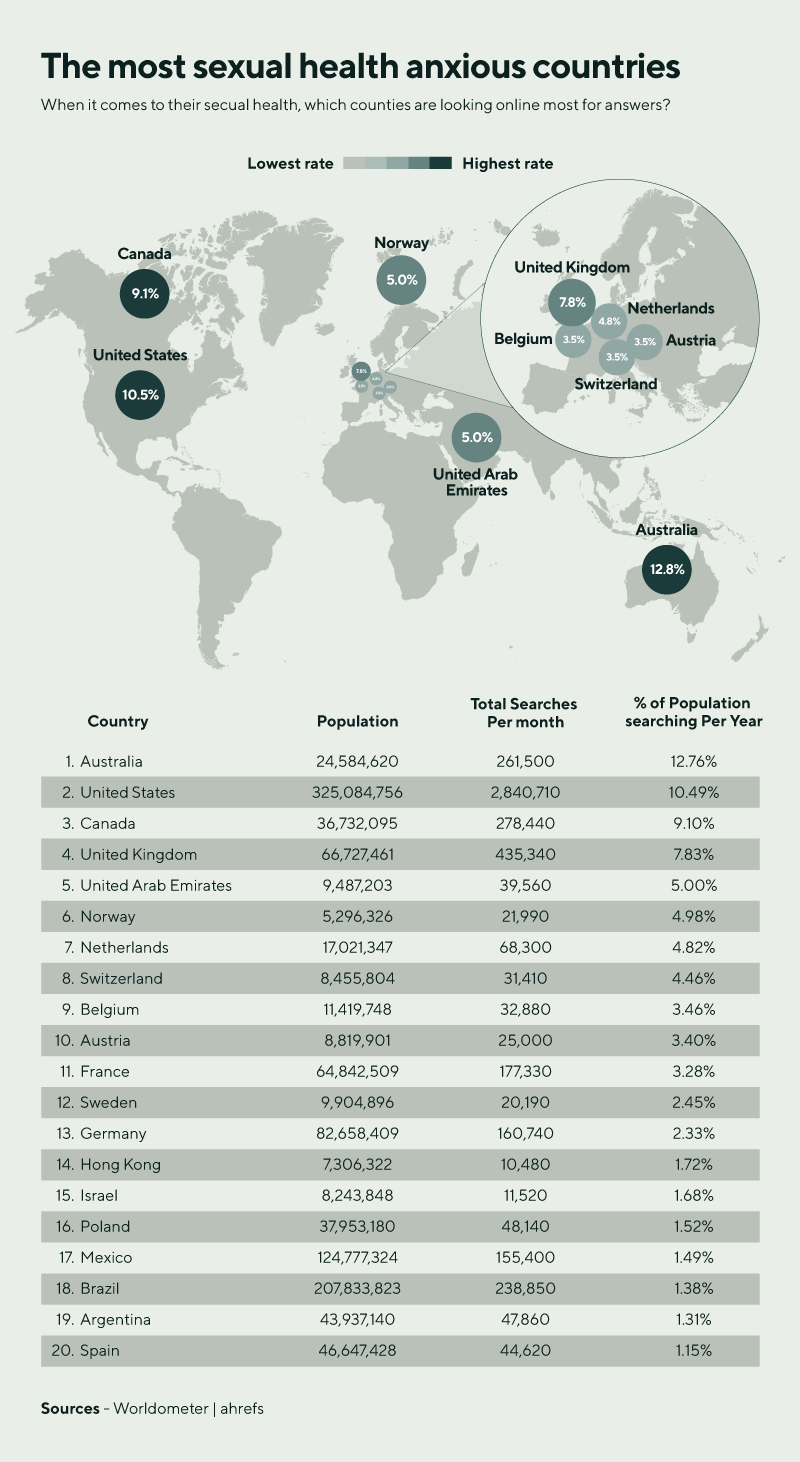
Finally, we trawled the internet to see which of the 30 countries we researched had the most anxious Google searches when it came to STIs. First up, the country that had the highest recorded number of searches was the US.
With a gargantuan population of 325,084,756 people and 0.87% taking to the internet, the country had racked up an impressive 2,840,710 searches for STI related topics per month.
Comparatively, the UK, with a population of 66,727,461, had 0.65% of people making 435,340 searches per month, highlighting a high level of STI anxiety.
Lastly, India, with a massive population of 1,338,676,785 people, were revealed to have 319,020 searches per month. With 0.02% of the population searching, the level of STI anxiety is low when compared to the other countries in the list.
However, Ness Cooper notes that “this could be down to the conservative and traditional cultures throughout the country, which view sexual issues as taboo and, in some areas, shameful.”
Conclusion: do these factors really make some people more susceptible to STIs?
Ness Cooper, Clinical Sexologist and sex and relationship expert, said “the research shown highlights that there are many factors that have an impact on how likely you are to contract an STI – far more than just where you are from.
“A huge issue that we face in the UK is the lack of education around sex in schools, especially when it comes to queer relationships and any kind of awareness of issues that are not heteronormative.
“Countries that do not have the NHS or free healthcare are, as highlighted in our research, more likely to have higher rates of recorded STI cases as the treatment to manage them is so unaffordable.
“The main thing that can help change these statistics would be more freedom of speech around the subject of sex and STIs, along with more accessibility to contraception from a young age.”
Methodology
Taking data from around the globe we have discovered the most common STIs.
England
Using government data from the past 10 years across England we have found out the STIs most diagnosed across gender, regions, age and sexuality
Sources: Public Health England | ONS
US
Taking data from the CDC, we have discovered the STIs most common in the US and the associated costs of each STI
Sources: CDC
Most Googled STI Questions
Taking common sexual health terms, we found the top relatedquestions the UK and world have been searching for on Google
Sources: ahrefs
STI Anxiety Around the World
Taking 30 countries and STI, symptoms and testing terms we found the countries searching most for STIs.
Sources: Worldometer | ahrefs
While we've ensured that everything you read on the Health Centre is medically reviewed and approved, information presented here is not intended to be a substitute for professional medical advice, diagnosis, or treatment. It should never be relied upon for specific medical advice. If you have any questions or concerns, please talk to your doctor.




